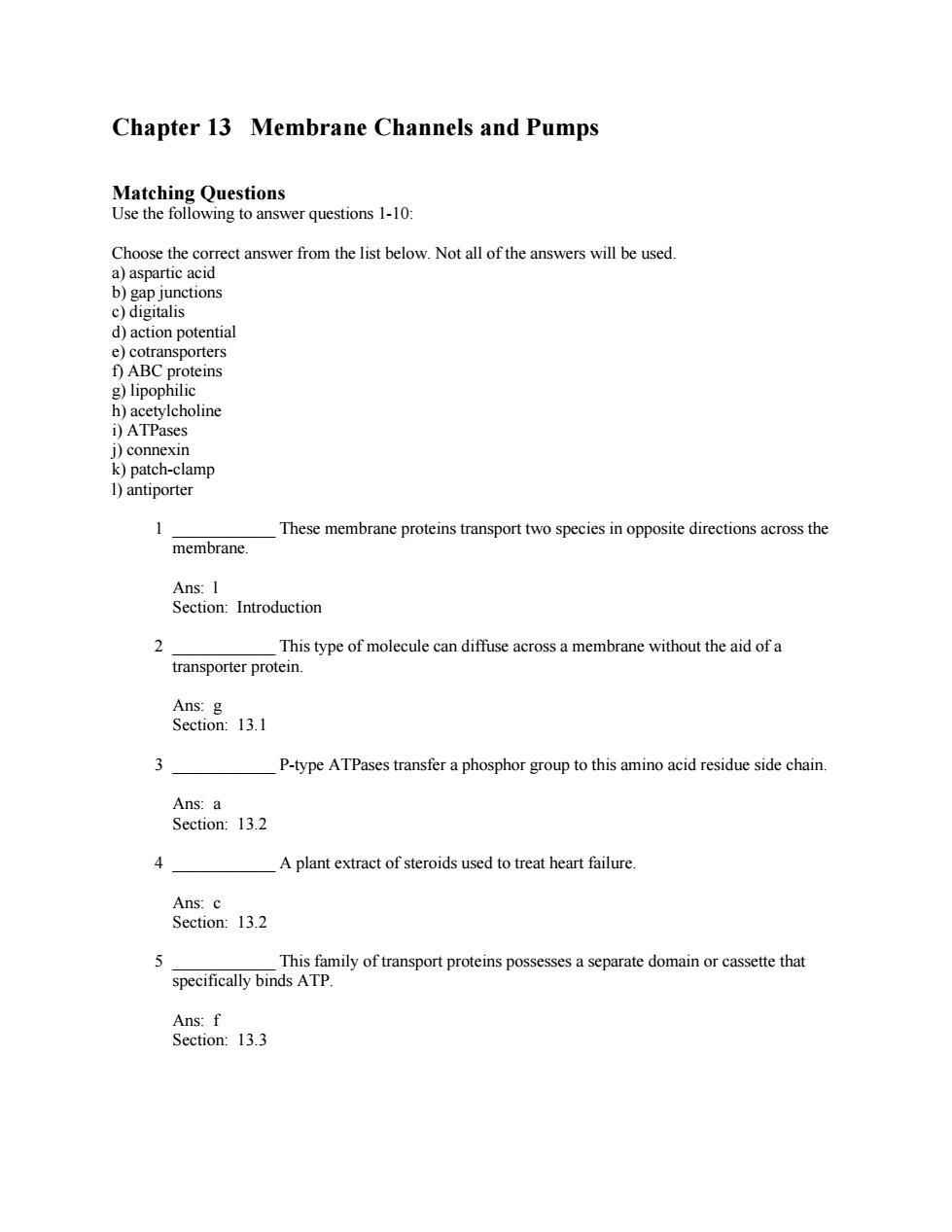
Chapter 13 Membrane Channels and Pumps Matching Questions Use the following to answer questions 1-10: Choose the correct answer from the list below.Not all of the answers will be used a)aspartic acid b)gap junctions c)digitalis d)action potential e)cotransporters f)ABC proteins g)lipophilic h)acetylcholine i)ATPases j)connexin k)patch-clamp 1)antiporter 1 These membrane proteins transport two species in opposite directions across the membrane. Ans:I Section:Introduction 2 This type of molecule can diffuse across a membrane without the aid of a transporter protein. Ans:g Section:13.1 3 P-type ATPases transfer a phosphor group to this amino acid residue side chain. Ans:a Section:13.2 A plant extract of steroids used to treat heart failure. Ans:c Section:13.2 This family of transport proteins possesses a separate domain or cassette that specifically binds ATP. Ans:f Section:13.3
Chapter 13 Membrane Channels and Pumps Matching Questions Use the following to answer questions 1-10: Choose the correct answer from the list below. Not all of the answers will be used. a) aspartic acid b) gap junctions c) digitalis d) action potential e) cotransporters f) ABC proteins g) lipophilic h) acetylcholine i) ATPases j) connexin k) patch-clamp l) antiporter 1 ____________ These membrane proteins transport two species in opposite directions across the membrane. Ans: l Section: Introduction 2 ____________ This type of molecule can diffuse across a membrane without the aid of a transporter protein. Ans: g Section: 13.1 3 ____________ P-type ATPases transfer a phosphor group to this amino acid residue side chain. Ans: a Section: 13.2 4 ____________ A plant extract of steroids used to treat heart failure. Ans: c Section: 13.2 5 ____________ This family of transport proteins possesses a separate domain or cassette that specifically binds ATP. Ans: f Section: 13.3
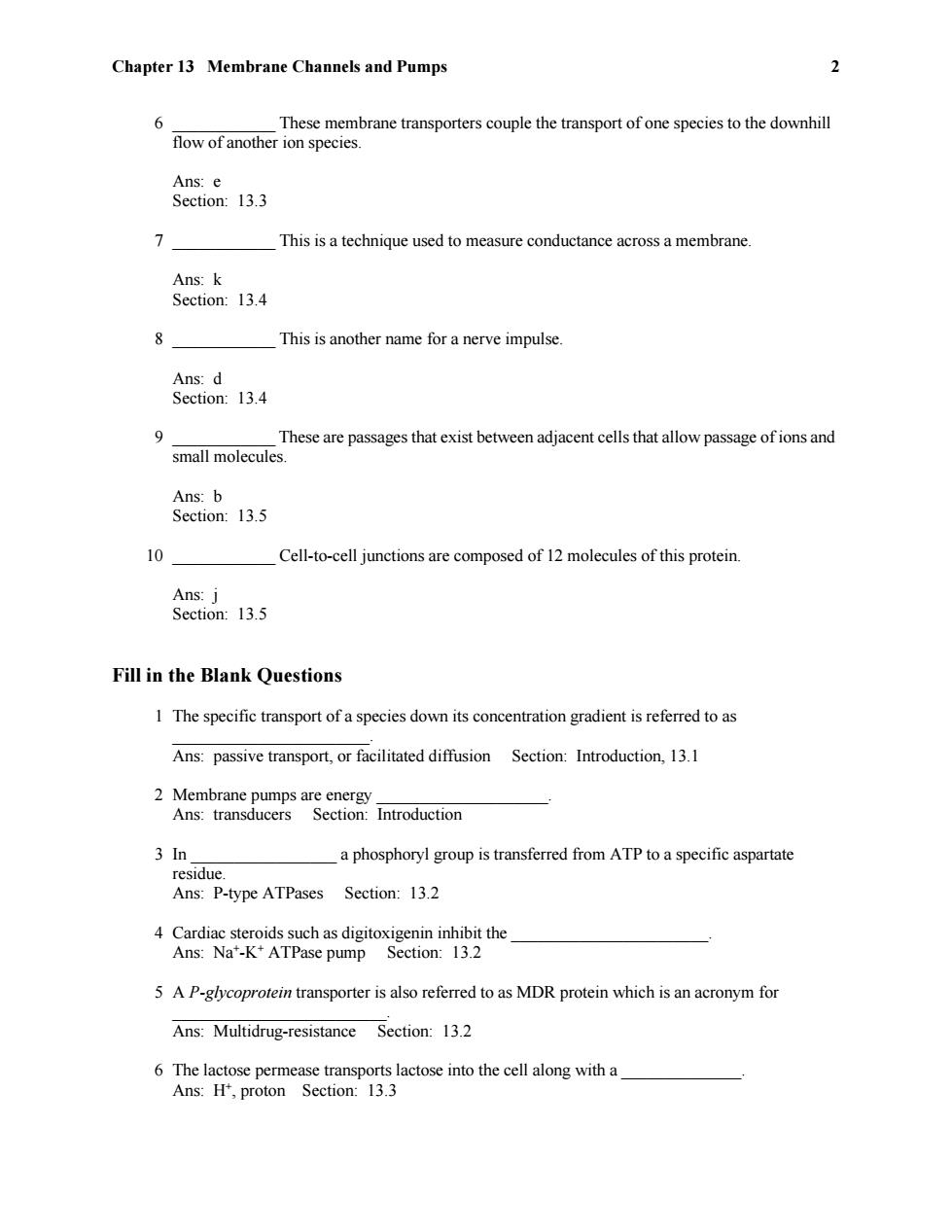
Chapter 13 Membrane Channels and Pumps 2 6 These membrane transporters couple the transport of one species to the downhill flow of another ion species. Ans:e Section:13.3 7 This is a technique used to measure conductance across a membrane. Ans:k Section:13.4 8 This is another name for a nerve impulse. Ans:d Section:13.4 9 These are passages that exist between adjacent cells that allow passage of ions and small molecules. Ans:b Section:13.5 10 Cell-to-cell junctions are composed of 12 molecules of this protein Ans:j Section:13.5 Fill in the Blank Questions 1 The specific transport of a species down its concentration gradient is referred to as Ans:passive transport,or facilitated diffusion Section:Introduction,13.1 2 Membrane pumps are energy Ans:transducers Section:Introduction 3 In a phosphoryl group is transferred from ATP to a specific aspartate residue. Ans:P-type ATPases Section:13.2 4 Cardiac steroids such as digitoxigenin inhibit the Ans:Na'-K*ATPase pump Section:13.2 5 A P-glycoprotein transporter is also referred to as MDR protein which is an acronym for Ans:Multidrug-resistance Section:13.2 6 The lactose permease transports lactose into the cell along with a Ans:H',proton Section:13.3
Chapter 13 Membrane Channels and Pumps 2 6 ____________ These membrane transporters couple the transport of one species to the downhill flow of another ion species. Ans: e Section: 13.3 7 ____________ This is a technique used to measure conductance across a membrane. Ans: k Section: 13.4 8 ____________ This is another name for a nerve impulse. Ans: d Section: 13.4 9 ____________ These are passages that exist between adjacent cells that allow passage of ions and small molecules. Ans: b Section: 13.5 10 ____________ Cell-to-cell junctions are composed of 12 molecules of this protein. Ans: j Section: 13.5 Fill in the Blank Questions 1 The specific transport of a species down its concentration gradient is referred to as _______________________. Ans: passive transport, or facilitated diffusion Section: Introduction, 13.1 2 Membrane pumps are energy ____________________. Ans: transducers Section: Introduction 3 In _________________ a phosphoryl group is transferred from ATP to a specific aspartate residue. Ans: P-type ATPases Section: 13.2 4 Cardiac steroids such as digitoxigenin inhibit the _______________________. Ans: Na + -K+ ATPase pump Section: 13.2 5 A P-glycoprotein transporter is also referred to as MDR protein which is an acronym for _________________________. Ans: Multidrug-resistance Section: 13.2 6 The lactose permease transports lactose into the cell along with a ______________. Ans: H+ , proton Section: 13.3
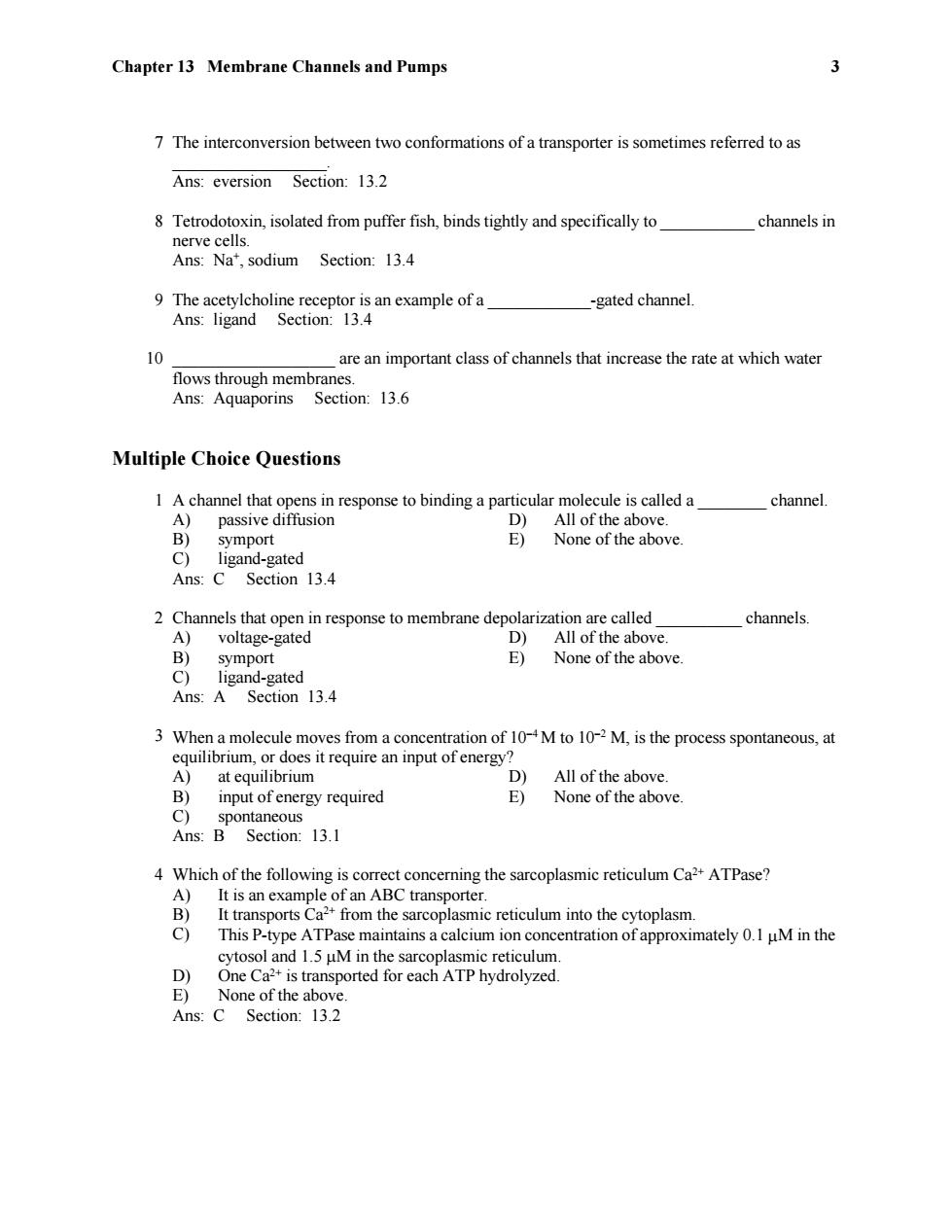
Chapter 13 Membrane Channels and Pumps 3 7 The interconversion between two conformations of a transporter is sometimes referred to as Ans:eversion Section:13.2 8 Tetrodotoxin,isolated from puffer fish,binds tightly and specifically to channels in nerve cells. Ans:Na,sodium Section:13.4 9 The acetylcholine receptor is an example of a -gated channel. Ans:ligand Section:13.4 10 are an important class of channels that increase the rate at which water flows through membranes. Ans:Aquaporins Section:13.6 Multiple Choice Questions 1 A channel that opens in response to binding a particular molecule is called a channel. A) passive diffusion D) All of the above. B) symport E) None of the above. C) ligand-gated Ans:C Section 13.4 2 Channels that open in response to membrane depolarization are called channels A) voltage-gated D) All of the above. symport E) None of the above. C) ligand-gated Ans:A Section 13.4 3 When a molecule moves from a concentration of 10-M to 10-2M,is the process spontaneous,at equilibrium,or does it require an input of energy? A) at equilibrium D) All of the above B) input of energy required E) None of the above. spontaneous Ans:B Section:13.1 4 Which of the following is correct concerning the sarcoplasmic reticulum Ca2+ATPase? A)It is an example of an ABC transporter. B) It transports Ca2+from the sarcoplasmic reticulum into the cytoplasm. C) This P-type ATPase maintains a calcium ion concentration of approximately 0.1 uM in the cytosol and 1.5 uM in the sarcoplasmic reticulum D) One Ca2+is transported for each ATP hydrolyzed. E)None of the above. Ans:C Section:13.2
Chapter 13 Membrane Channels and Pumps 3 7 The interconversion between two conformations of a transporter is sometimes referred to as __________________. Ans: eversion Section: 13.2 8 Tetrodotoxin, isolated from puffer fish, binds tightly and specifically to ___________ channels in nerve cells. Ans: Na + , sodium Section: 13.4 9 The acetylcholine receptor is an example of a ____________-gated channel. Ans: ligand Section: 13.4 10 ___________________ are an important class of channels that increase the rate at which water flows through membranes. Ans: Aquaporins Section: 13.6 Multiple Choice Questions 1 A channel that opens in response to binding a particular molecule is called a ________ channel. A) passive diffusion D) All of the above. B) symport E) None of the above. C) ligand-gated Ans: C Section 13.4 2 Channels that open in response to membrane depolarization are called __________ channels. A) voltage-gated D) All of the above. B) symport E) None of the above. C) ligand-gated Ans: A Section 13.4 3 When a molecule moves from a concentration of 10 4M to 10 2 M, is the process spontaneous, at equilibrium, or does it require an input of energy? A) at equilibrium D) All of the above. B) input of energy required E) None of the above. C) spontaneous Ans: B Section: 13.1 4 Which of the following is correct concerning the sarcoplasmic reticulum Ca 2+ ATPase? A) It is an example of an ABC transporter. B) It transports Ca 2+ from the sarcoplasmic reticulum into the cytoplasm. C) This P-type ATPase maintains a calcium ion concentration of approximately 0.1 M in the cytosol and 1.5 M in the sarcoplasmic reticulum. D) One Ca 2+ is transported for each ATP hydrolyzed. E) None of the above. Ans: C Section: 13.2
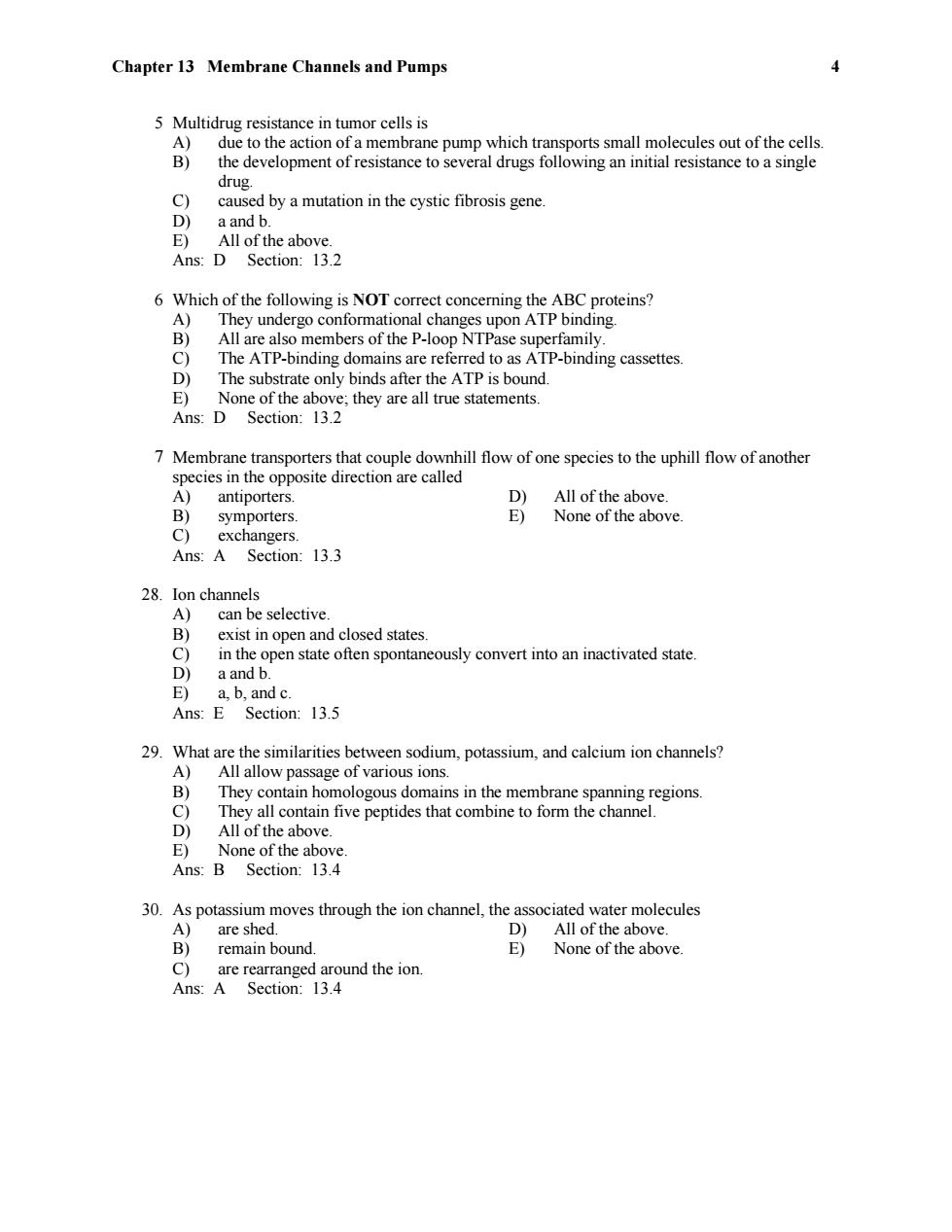
Chapter 13 Membrane Channels and Pumps 4 5 Multidrug resistance in tumor cells is A)due to the action of a membrane pump which transports small molecules out of the cells. B) the development of resistance to several drugs following an initial resistance to a single drug. C) caused by a mutation in the cystic fibrosis gene. D) a and b. E)All of the above. Ans:D Section:13.2 6 Which of the following is NOT correct concerning the ABC proteins? A) They undergo conformational changes upon ATP binding B) All are also members of the P-loop NTPase superfamily. C) The ATP-binding domains are referred to as ATP-binding cassettes. D) The substrate only binds after the ATP is bound. E)None of the above;they are all true statements. Ans:D Section:13.2 7 Membrane transporters that couple downhill flow of one species to the uphill flow of another species in the opposite direction are called A)antiporters. D All of the above. B) symporters. E) None of the above. c) exchangers. Ans:A Section:13.3 28.Ion channels A) can be selective. B) exist in open and closed states. C) in the open state often spontaneously convert into an inactivated state. D) a and b. E) a.b,and c. Ans:E Section:13.5 29.What are the similarities between sodium,potassium,and calcium ion channels? A)All allow passage of various ions. B) They contain homologous domains in the membrane spanning regions C) They all contain five peptides that combine to form the channel. D) All of the above. E)None of the above. Ans:B Section:13.4 30.As potassium moves through the ion channel,the associated water molecules A)are shed. D)All of the above. B) remain bound. E) None of the above. C)are rearranged around the ion. Ans:A Section:13.4
Chapter 13 Membrane Channels and Pumps 4 5 Multidrug resistance in tumor cells is A) due to the action of a membrane pump which transports small molecules out of the cells. B) the development of resistance to several drugs following an initial resistance to a single drug. C) caused by a mutation in the cystic fibrosis gene. D) a and b. E) All of the above. Ans: D Section: 13.2 6 Which of the following is NOT correct concerning the ABC proteins? A) They undergo conformational changes upon ATP binding. B) All are also members of the P-loop NTPase superfamily. C) The ATP-binding domains are referred to as ATP-binding cassettes. D) The substrate only binds after the ATP is bound. E) None of the above; they are all true statements. Ans: D Section: 13.2 7 Membrane transporters that couple downhill flow of one species to the uphill flow of another species in the opposite direction are called A) antiporters. D) All of the above. B) symporters. E) None of the above. C) exchangers. Ans: A Section: 13.3 28. Ion channels A) can be selective. B) exist in open and closed states. C) in the open state often spontaneously convert into an inactivated state. D) a and b. E) a, b, and c. Ans: E Section: 13.5 29. What are the similarities between sodium, potassium, and calcium ion channels? A) All allow passage of various ions. B) They contain homologous domains in the membrane spanning regions. C) They all contain five peptides that combine to form the channel. D) All of the above. E) None of the above. Ans: B Section: 13.4 30. As potassium moves through the ion channel, the associated water molecules A) are shed. D) All of the above. B) remain bound. E) None of the above. C) are rearranged around the ion. Ans: A Section: 13.4
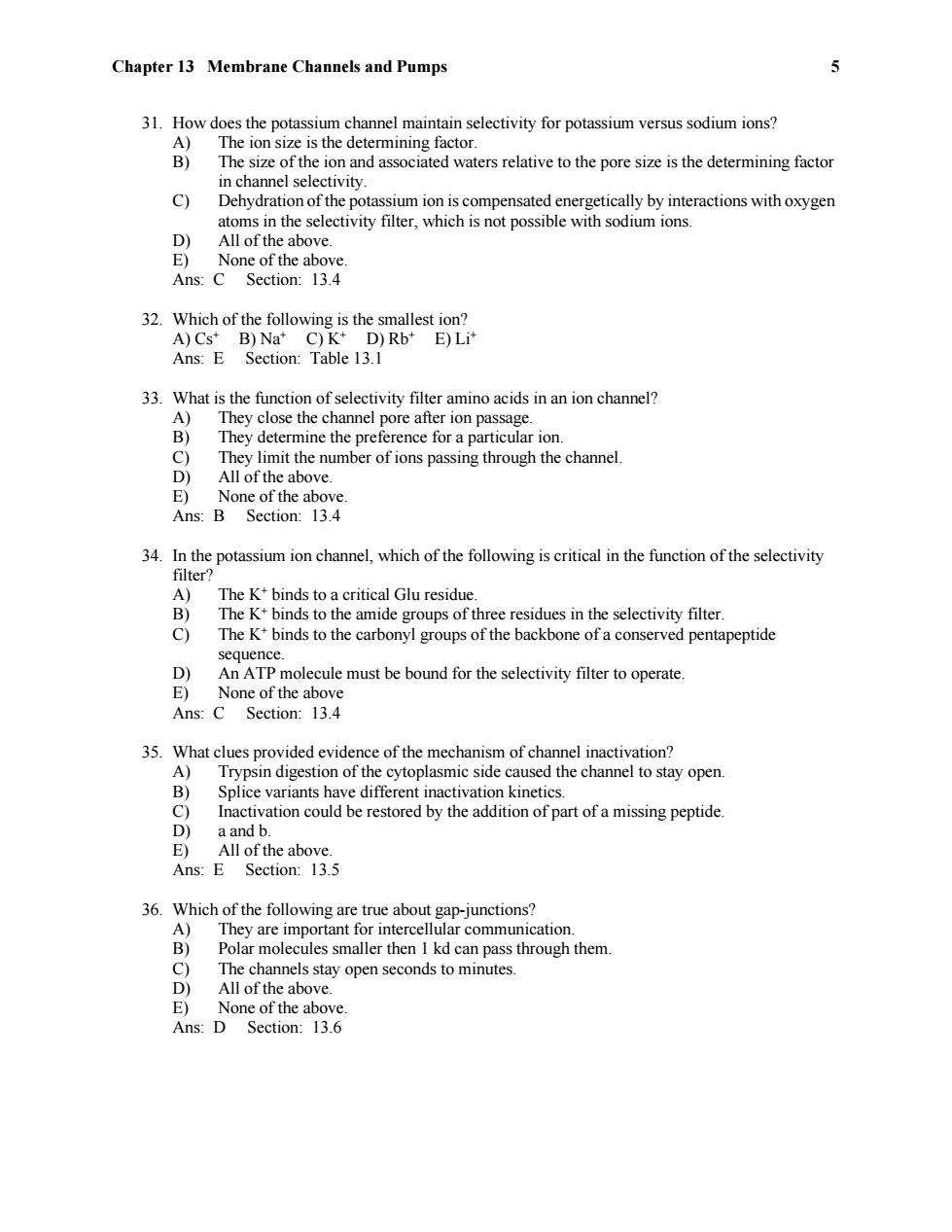
Chapter 13 Membrane Channels and Pumps 31.How does the potassium channel maintain selectivity for potassium versus sodium ions? A) The ion size is the determining factor. B) The size of the ion and associated waters relative to the pore size is the determining factor in channel selectivity. c) Dehydration of the potassium ion is compensated energetically by interactions with oxygen atoms in the selectivity filter,which is not possible with sodium ions. D) All of the above. E) None of the above. Ans:C Section:13.4 32.Which of the following is the smallest ion? A)Cs*B)Na+C)K+D)Rb+E)Lit Ans:E Section:Table 13.1 33.What is the function of selectivity filter amino acids in an ion channel? A)They close the channel pore after ion passage. B) They determine the preference for a particular ion. C) They limit the number of ions passing through the channel. D) All of the above. E) None of the above. Ans:B Section:13.4 34.In the potassium ion channel,which of the following is critical in the function of the selectivity filter? A The K+binds to a critical Glu residue. B) The K+binds to the amide groups of three residues in the selectivity filter. C) The K+binds to the carbonyl groups of the backbone of a conserved pentapeptide sequence. D) An ATP molecule must be bound for the selectivity filter to operate. E) None of the above Ans:C Section:13.4 35.What clues provided evidence of the mechanism of channel inactivation? A)Trypsin digestion of the cytoplasmic side caused the channel to stay open. B) Splice variants have different inactivation kinetics. C) Inactivation could be restored by the addition of part of a missing peptide. D) a and b. E)All of the above. Ans:E Section:13.5 36.Which of the following are true about gap-junctions? A)They are important for intercellular communication. B) Polar molecules smaller then 1 kd can pass through them. C) The channels stay open seconds to minutes. D)All of the above. E)None of the above. Ans:D Section:13.6
Chapter 13 Membrane Channels and Pumps 5 31. How does the potassium channel maintain selectivity for potassium versus sodium ions? A) The ion size is the determining factor. B) The size of the ion and associated waters relative to the pore size is the determining factor in channel selectivity. C) Dehydration of the potassium ion is compensated energetically by interactions with oxygen atoms in the selectivity filter, which is not possible with sodium ions. D) All of the above. E) None of the above. Ans: C Section: 13.4 32. Which of the following is the smallest ion? A) Cs + B) Na + C) K+ D) Rb + E) Li+ Ans: E Section: Table 13.1 33. What is the function of selectivity filter amino acids in an ion channel? A) They close the channel pore after ion passage. B) They determine the preference for a particular ion. C) They limit the number of ions passing through the channel. D) All of the above. E) None of the above. Ans: B Section: 13.4 34. In the potassium ion channel, which of the following is critical in the function of the selectivity filter? A) The K+ binds to a critical Glu residue. B) The K+ binds to the amide groups of three residues in the selectivity filter. C) The K+ binds to the carbonyl groups of the backbone of a conserved pentapeptide sequence. D) An ATP molecule must be bound for the selectivity filter to operate. E) None of the above Ans: C Section: 13.4 35. What clues provided evidence of the mechanism of channel inactivation? A) Trypsin digestion of the cytoplasmic side caused the channel to stay open. B) Splice variants have different inactivation kinetics. C) Inactivation could be restored by the addition of part of a missing peptide. D) a and b. E) All of the above. Ans: E Section: 13.5 36. Which of the following are true about gap-junctions? A) They are important for intercellular communication. B) Polar molecules smaller then 1 kd can pass through them. C) The channels stay open seconds to minutes. D) All of the above. E) None of the above. Ans: D Section: 13.6